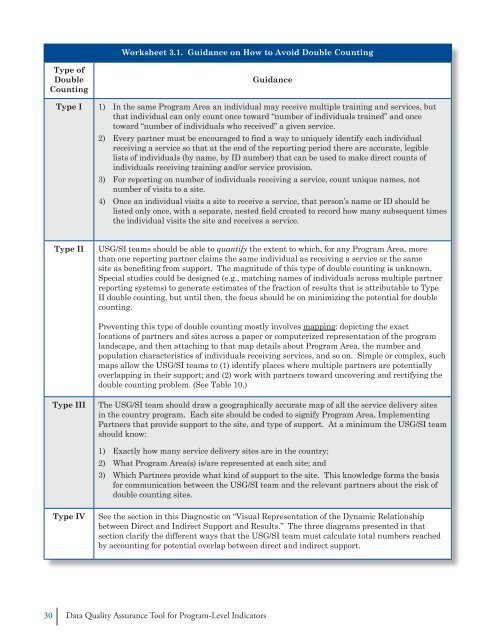Data quality assurance tool for program-level indicators
Data quality assurance tool for program-level indicators
Data quality assurance tool for program-level indicators
You also want an ePaper? Increase the reach of your titles
YUMPU automatically turns print PDFs into web optimized ePapers that Google loves.
Type of<br />
Double<br />
Counting<br />
Worksheet 3.1. Guidance on How to Avoid Double Counting<br />
0 <strong>Data</strong> Quality Assurance Tool <strong>for</strong> Program-Level Indicators<br />
Guidance<br />
Type I 1) In the same Program Area an individual may receive multiple training and services, but<br />
that individual can only count once toward “number of individuals trained” and once<br />
toward “number of individuals who received” a given service.<br />
2)<br />
3)<br />
4)<br />
Every partner must be encouraged to find a way to uniquely identify each individual<br />
receiving a service so that at the end of the reporting period there are accurate, legible<br />
lists of individuals (by name, by ID number) that can be used to make direct counts of<br />
individuals receiving training and/or service provision.<br />
For reporting on number of individuals receiving a service, count unique names, not<br />
number of visits to a site.<br />
Once an individual visits a site to receive a service, that person’s name or ID should be<br />
listed only once, with a separate, nested field created to record how many subsequent times<br />
the individual visits the site and receives a service.<br />
Type II USG/SI teams should be able to quantify the extent to which, <strong>for</strong> any Program Area, more<br />
than one reporting partner claims the same individual as receiving a service or the same<br />
site as benefiting from support. The magnitude of this type of double counting is unknown.<br />
Special studies could be designed (e.g., matching names of individuals across multiple partner<br />
reporting systems) to generate estimates of the fraction of results that is attributable to Type<br />
II double counting, but until then, the focus should be on minimizing the potential <strong>for</strong> double<br />
counting.<br />
Preventing this type of double counting mostly involves mapping: depicting the exact<br />
locations of partners and sites across a paper or computerized representation of the <strong>program</strong><br />
landscape, and then attaching to that map details about Program Area, the number and<br />
population characteristics of individuals receiving services, and so on. Simple or complex, such<br />
maps allow the USG/SI teams to (1) identify places where multiple partners are potentially<br />
overlapping in their support; and (2) work with partners toward uncovering and rectifying the<br />
double counting problem. (See Table 10.)<br />
Type III The USG/SI team should draw a geographically accurate map of all the service delivery sites<br />
in the country <strong>program</strong>. Each site should be coded to signify Program Area, Implementing<br />
Partners that provide support to the site, and type of support. At a minimum the USG/SI team<br />
should know:<br />
1)<br />
2)<br />
3)<br />
Exactly how many service delivery sites are in the country;<br />
What Program Area(s) is/are represented at each site; and<br />
Which Partners provide what kind of support to the site. This knowledge <strong>for</strong>ms the basis<br />
<strong>for</strong> communication between the USG/SI team and the relevant partners about the risk of<br />
double counting sites.<br />
Type IV See the section in this Diagnostic on “Visual Representation of the Dynamic Relationship<br />
between Direct and Indirect Support and Results.” The three diagrams presented in that<br />
section clarify the different ways that the USG/SI team must calculate total numbers reached<br />
by accounting <strong>for</strong> potential overlap between direct and indirect support.


